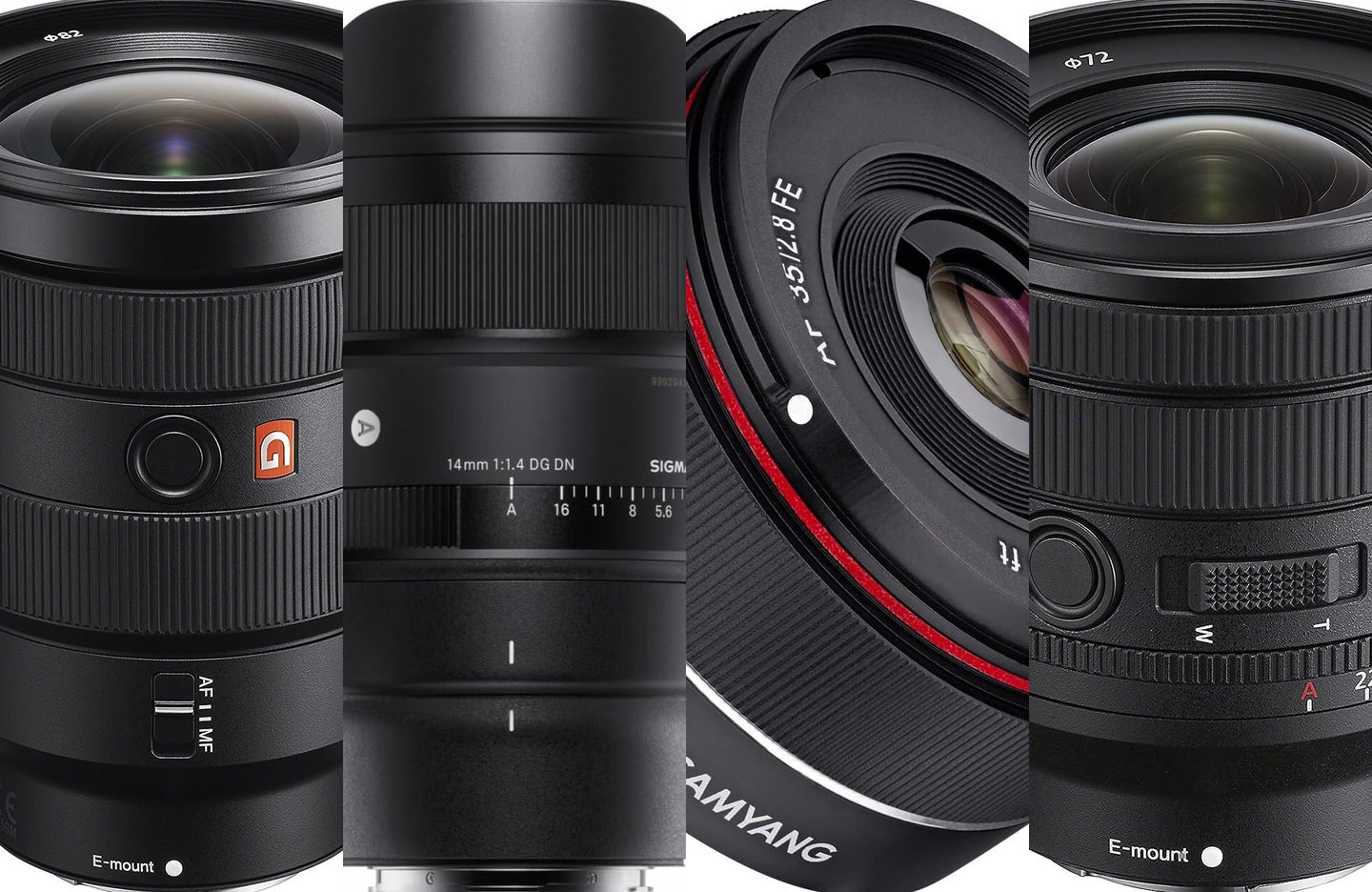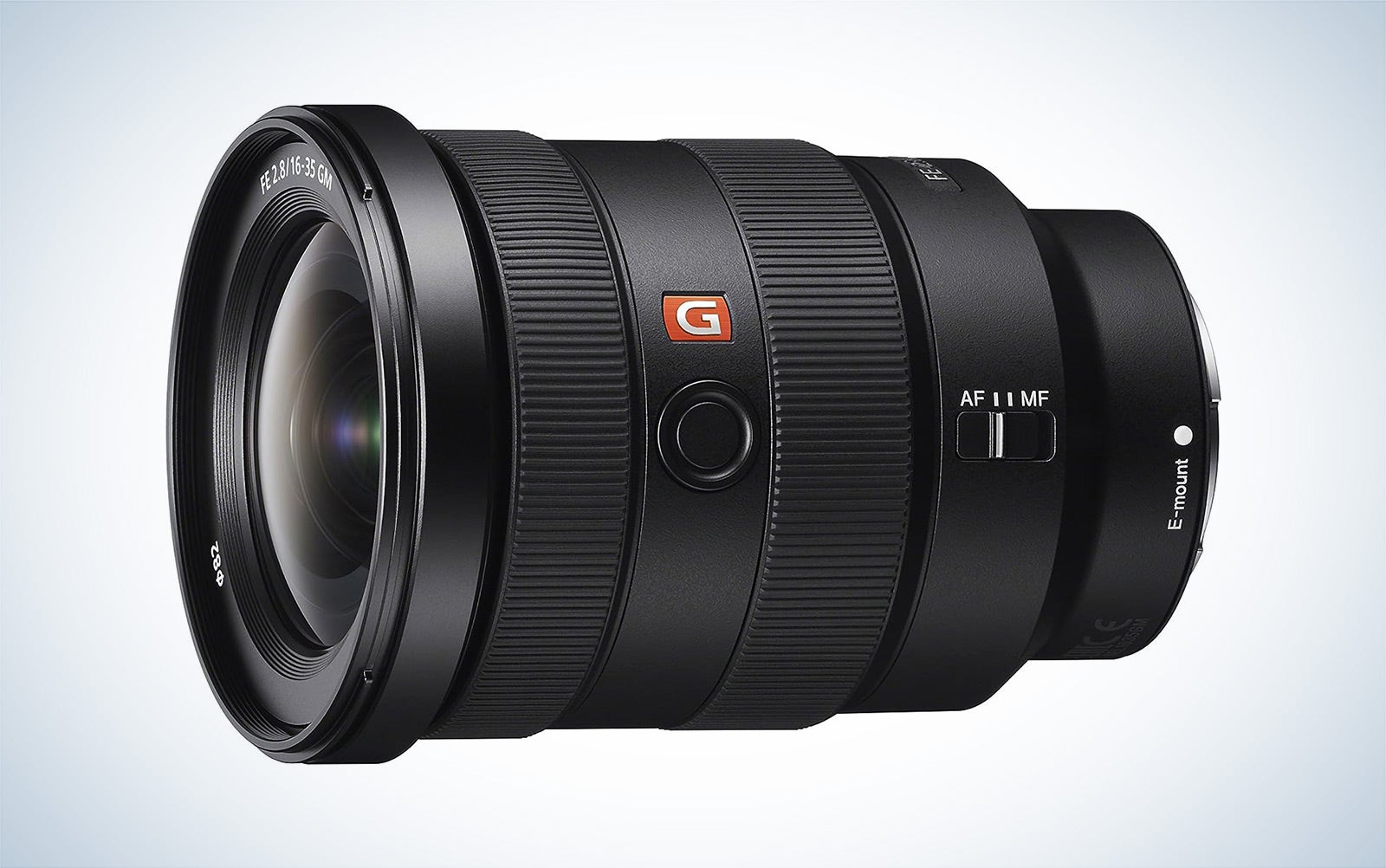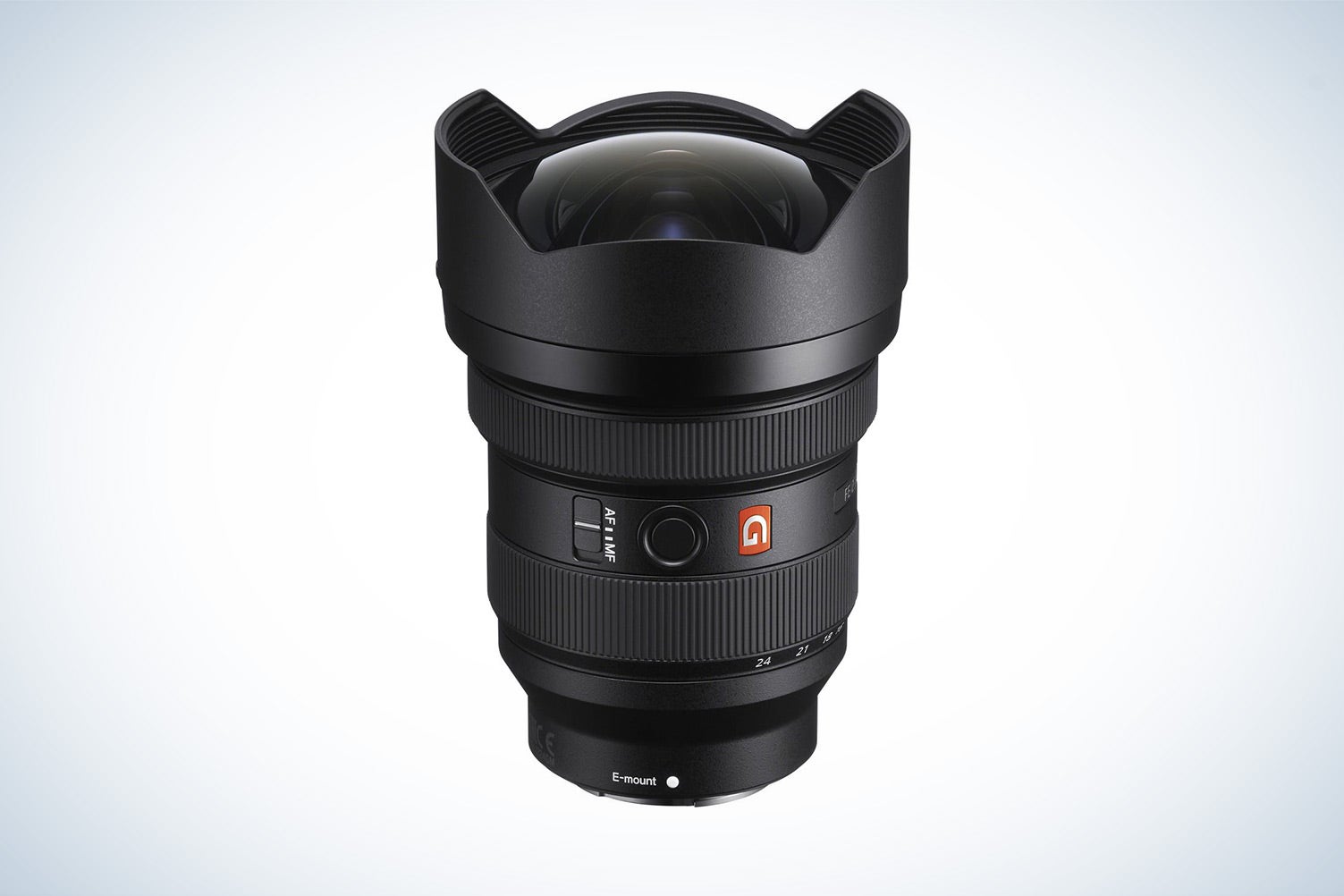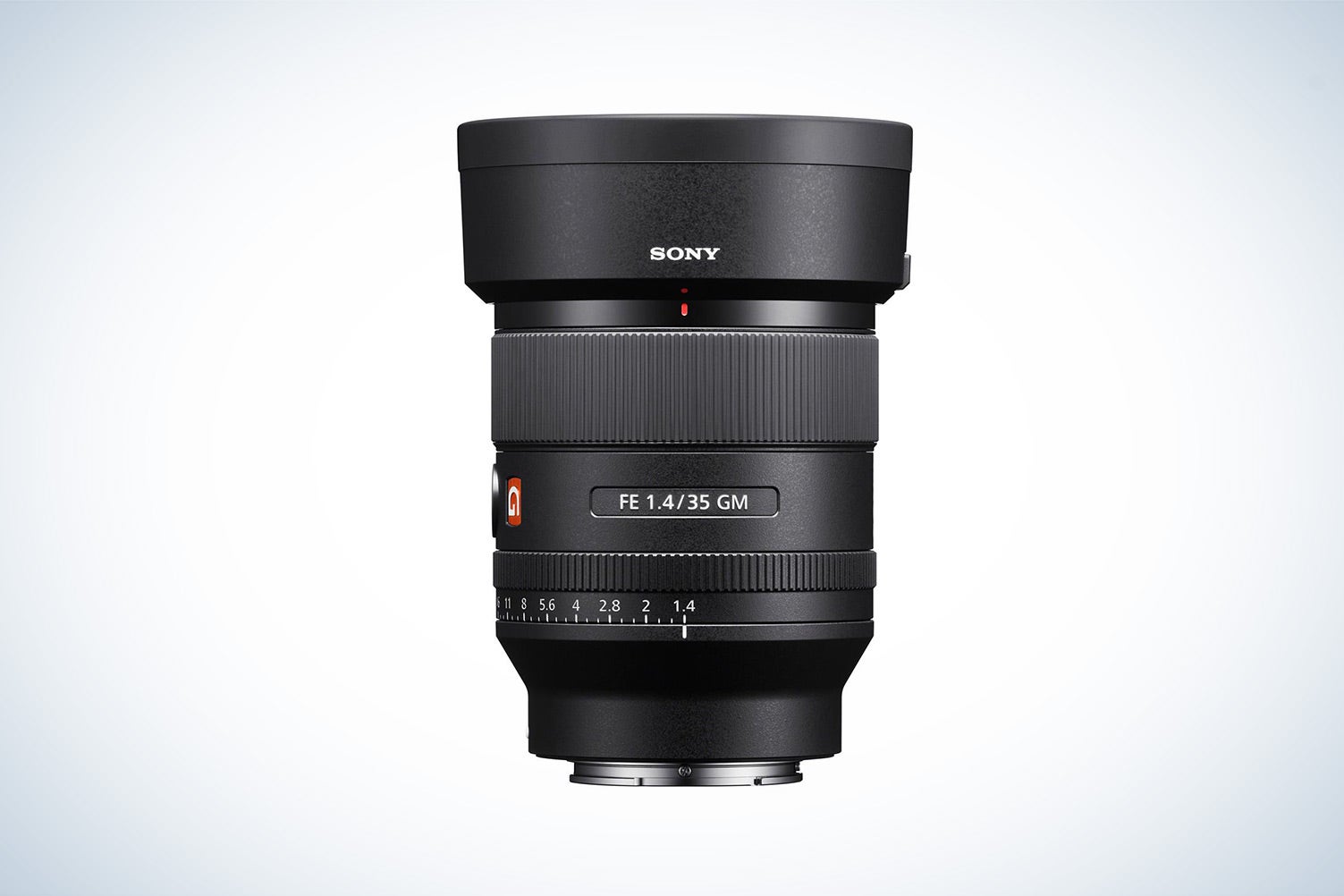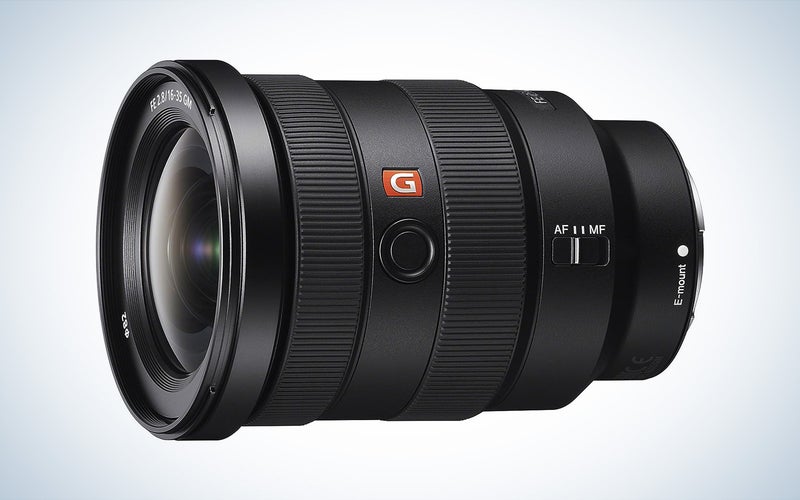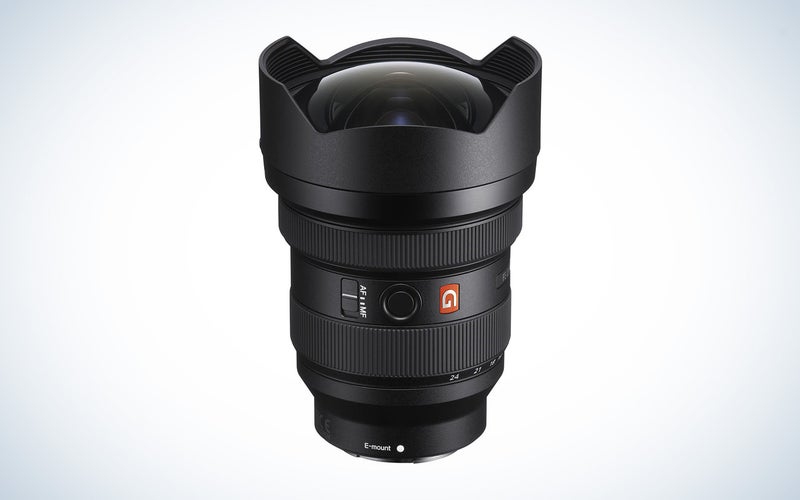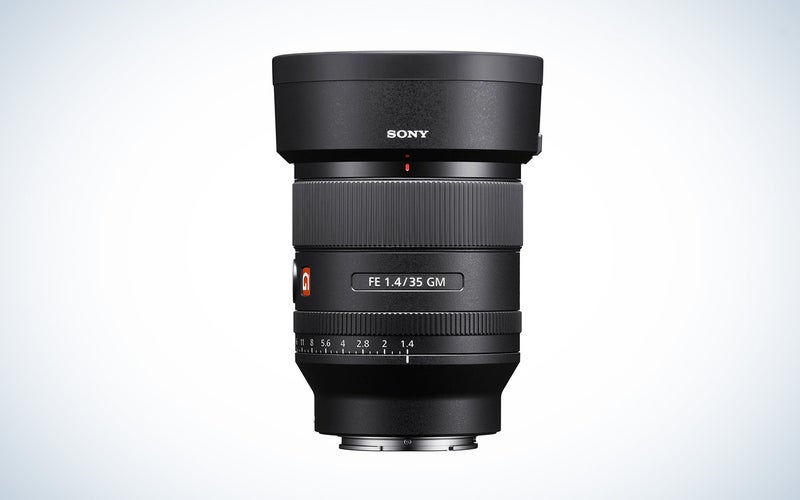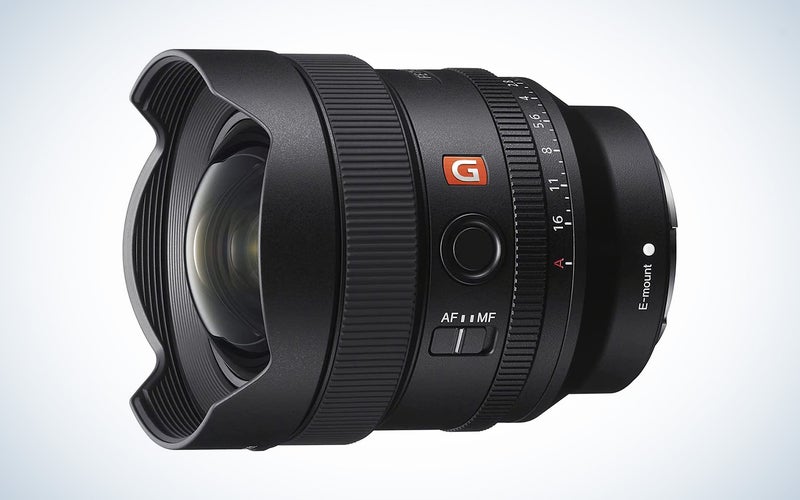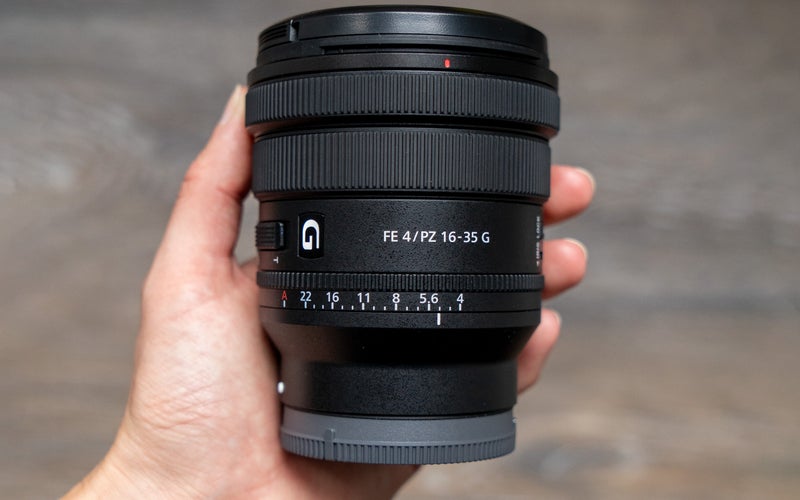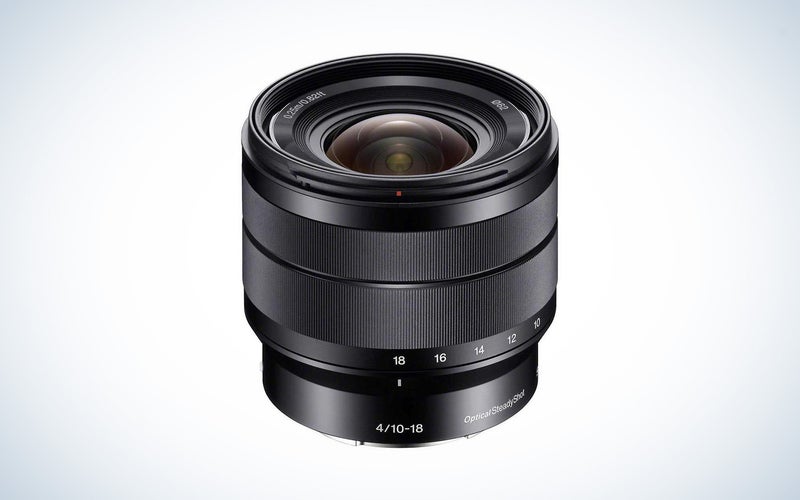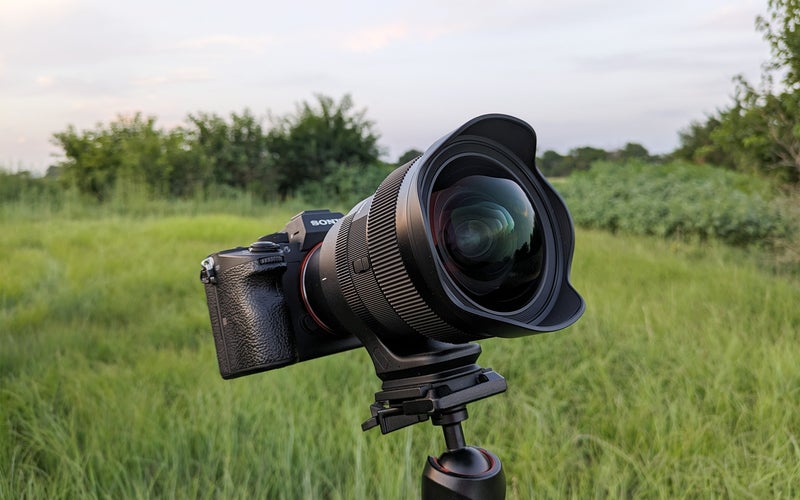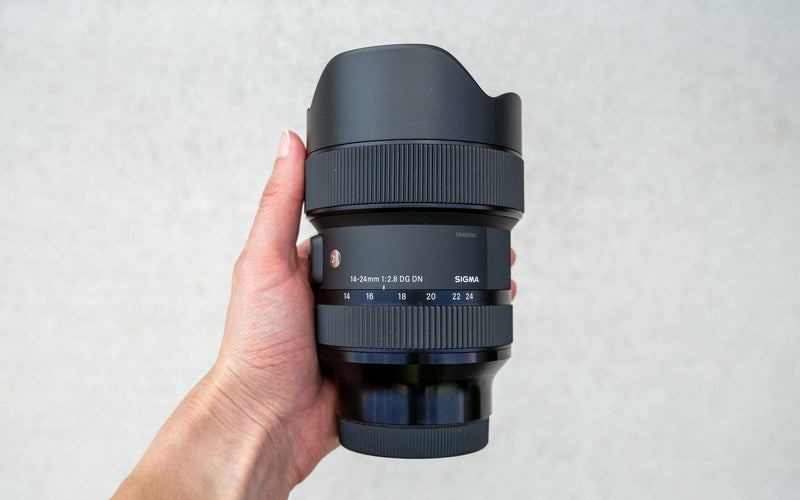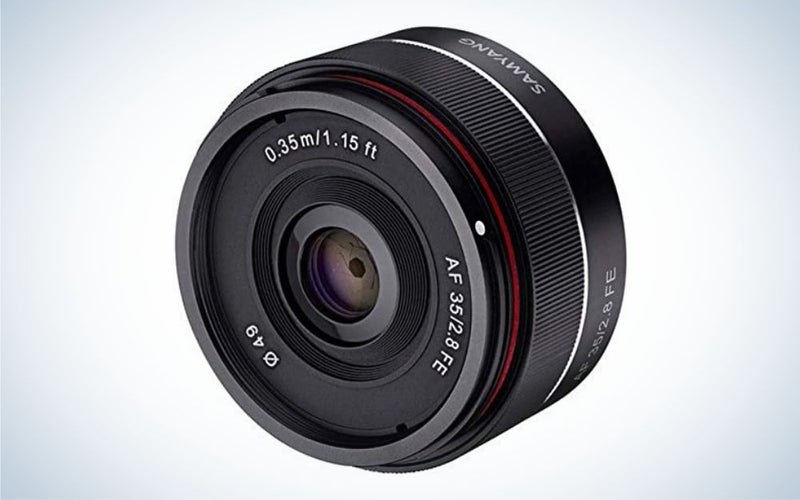We may earn revenue from the products available on this page and participate in affiliate programs. Learn more ›
Wide-angle lenses for Sony shooters—and everyone else—represent an essential piece of kit in a well-rounded gear bag. Wide-angle lenses provide a broad, sweeping angle of view. They allow you to show more in a single frame without physically stepping back from the scene, which is sometimes impossible. The wide-focal lengths come in handy in a plethora of photographic situations, from real estate and landscapes to group photos at weddings. They can also help you stretch your creativity and get unique shots that wouldn’t be possible without a wide angle. The best wide-angle lenses for Sony will help you capture anything that calls for that broader viewpoint.
- Best overall: Sony FE 16-35mm f/2.8 GM
- Best ultra-wide: Sony FE 12-24mm f/2.8 GM
- Best prime: Sony FE 35mm f/1.4 GM
- Best ultra-wide prime: Sony FE 14mm f/1.8 GM
- Best for video: Sony FE PZ 16-35mm f/4 G
- Best for Sony ASP-C: Sony E PZ 10-18mm f/4 OSS
- Best for astrophotography: Sigma 14mm f/1.4 DG DN Art
- Best third-party: Sigma 14-24mm f/2.8 DG DN Art
- Best budget: Samyang AF 35mm f/2.8 FE
How we chose the best wide-angle lenses for Sony
When selecting the best wide-angle lenses for Sony, we considered the various ways a wide-angle lens can be utilized. We aimed to include a lens for every situation, from portraiture to real estate and even video. Beyond that, image quality was the primary consideration when compiling the included lenses. Aperture was also a significant factor, as many wide-angle situations also require a fast aperture due to limited light. Finally, we considered lens weight, weatherproofing, focusing abilities, additional features like lens controls and markings, and finally, price.
The best wide-angle lenses for Sony: Reviews & recommendations
There is no shortage of wide-angle lenses for Sony cameras. Between Sony’s robust lineup and extensive third-party options, it can be tricky to figure out what to get. Below you’ll find some of our favorites, as well as tips on how to choose.
Best overall: Sony FE 16-35mm f/2.8 GM
Sony
Specs
- Lens mount: E-mount, full-frame
- Aperture range: f/2.8 – f/22
- Image stabilization: No
- Filter size: 82 mm
- Minimum focus distance: 11 inches
- Weight: 1.5 pounds
- Dimensions: 3.5 x 4.8 – 5.4 inches
Pros
- Very sharp even at f/2.8
- Attractive bokeh
- Silent autofocus
- Weather sealed
Cons
- Expensive
- Rather large
Sony’s 16-35mm f/2.8 is a superb choice if you want one wide-angle lens to cover your bases. The focal length range makes it ideal for many genres; it can be your workhorse of a lens even if you shoot a bit of everything (at the wide-angle side, of course). It provides plenty of ultra-wide range for large group shots and even real estate photography but also covers the more subdued end of wide-angles at 35mm for environmental portrait and detail work. You won’t have to switch lenses nearly as much with this option. And it has a fast f/2.8 aperture, making it useful for low-light situations, including astrophotography.
That wide aperture also allows for a shallower depth of field. Combined with the rounded 11-blade diaphragm, you’ll be able to get very attractive bokeh, allowing for portraits with good separation from the background. Two Direct Drive Supersonic Motors control the autofocus, which is essentially silent. The quiet autofocus makes it suitable for video, as you won’t be able to hear annoying focusing noises while recording.
In terms of construction, as you would expect from a G Master lens, it has a sturdy build with weather sealing. And it has a fluorine coating on the front element to help keep that clean and free of fingerprints and dust. Sony designed this lens with 16 elements in 13 groups, including two extreme aspherical and three standard aspherical, to reduce undesired things like distortion and aberration. As with any lens this wide, you will get some distortion, but Sony cameras automatically adjust for this, so you won’t even have to think about it. Even if you turn that automatic adjustment off, it is easy to correct in editing.
This lens has two main downsides: Its weight and price. It definitely has a G Master price and costs a pretty penny. And, weighing 1.5 pounds and measuring 3.5 x 4.8-5.4 inches, it’s not a small or light lens. Should you be in a situation where you need to cut back on your kit’s weight, more compact options are available, such as the Sony 16-35mm Vario-Tessar T FE F4 ZA OSS. You lose a stop of light with that particular choice, but it is significantly cheaper and smaller, making it another attractive option.
Best ultra-wide: Sony FE 12-24mm f/2.8 GM
Sony
Specs
- Lens mount: E-mount, full-frame
- Aperture range: f/2.8 – f/22
- Image stabilization: No
- Filter size: Rear filters only
- Minimum focus distance: 11.02 inches
- Weight: 1.86 pounds
- Dimensions: 3.84 x 5.39 inches
Pros
- Exceptional sharpness
- Fast aperture
- Fast and accurate autofocus
- Weather sealed
Cons
- Heavy
- Bulbous front element doesn’t accept filters
For those who need an ultra-wide viewpoint, Sony’s 12-24mm f/2.8 GM offers exceptional quality. As with all G Master lenses, it comes at a high price, but we believe it’s worth it. While other ultra-wide-angle options are available, they either start at 14mm or only offer a max aperture of f/4. That means you either lose a stop of aperture or 2mm of focal length. And although 2mm might not sound like a lot, it makes a surprising difference. It’s especially noticeable when used in smaller rooms. 12mm may be more than some genres need, but real estate photographers will benefit from the extra bit of reach this lens provides.
Any lens this wide will have at least some distortion, and that holds true for Sony’s 12-24mm. It is very well controlled, however, and you’ll easily be able to correct it. The same is true for vignetting. There is some darkening in the corners, but adjusting without extreme measures is very simple. Sony used its second-generation Nano AR Coating for the first time on this lens, and it does an incredible job cutting out flares and ghosting. It really is impressive how clear images are when the sun is directly in the frame.
Another exceptional aspect of this lens is its sharpness. There is excellent sharpness even when shooting wide open. You will see some slight softness on the edges at f/2.8, though that should be expected. Stopped down, this lens is incredible across the frame.
Of course, there are some downsides, though they are inherent to just about any lens of this type. The front element is bulbous, so you won’t be able to use front filters. But it is compatible with rear drop-in filters, so landscape photographers can still take advantage of those. It’s also a heavy lens, weighing 1.86 pounds. But, there simply aren’t any other wide-angle lenses for Sony that offer a 14mm focal length with an aperture as fast. It’s expensive, yes, but it ticks a lot of boxes.
Best prime: Sony FE 35mm f/1.4 GM Lens
Sony
Specs
- Lens mount: E-mount, full-frame
- Aperture range: f/1.4 – f/16
- Image stabilization: No
- Filter size: 67mm
- Minimum focus distance: 9.8 inches
- Weight: 1.2 pounds
- Dimensions: 3 x 3.8 inches
Pros
- Very fast maximum aperture
- Close minimum focusing distance
- Compact size
- Aperture ring can be de-clicked for silent operation
Cons
- Focus breathing is noticeable
A 35mm prime is a great piece of equipment to have in your arsenal. It’s a highly versatile focal length, which is why it’s the lens of choice for photojournalists, event photographers, and even family photographers.
While the 16-35mm mentioned above obviously offers 35mm, this prime lens provides a faster aperture and is nearly two inches shorter when the zoom lens is set to 35mm. Sigma also offers a 35mm prime with an even faster aperture (f/1.2), but it is twice as heavy and closer to the dimensions of a zoom lens. Sony’s 35mm is nicely compact and lightweight, making it easy to throw in your kit for a trip. It will also balance nicely on your Sony camera and work well on gimbals.
Though wide-angle lenses aren’t typically used for closeups, this lens can focus as close as 9.8 inches, which results in 1:3.8 life-size reproduction. It’s by no means a replacement for a proper macro lens. Still, it will be useful for getting those essential detail shots at weddings while allowing you to quickly return to taking portraits without switching lenses.
Thanks to the wide f/1.4 aperture and the 11-blade diaphragm, it’s easy to get background blur with beautiful bokeh. You’ll be able to get a nice separation between your subject and the background, perfect for portraits or detail shots. The lens is also extremely sharp, even when wide open or stopped all the way down. You can use essentially any aperture with this one and not worry about losing out on quality.
Autofocus is quick, accurate, and quiet. However, videographers need to be aware that there is noticeable focus breathing. On the other hand, a plus for videographers is that the focus ring can be de-clicked for silent operation. Although the older version of this lens—the Sony Zeiss 35mm F1.4 ZA—is still very capable and much cheaper, you simply get a lot more quality from this newer version.
Best ultra-wide prime: Sony FE 14mm f/1.8 GM
Sony
Specs
- Lens mount: E-mount, full-frame
- Aperture range: f/1.8 – f/16
- Image stabilization: No
- Filter size: Rear filters only
- Minimum focus distance: 9.8 inches
- Weight: 1 pound
- Dimensions: 3.3 x 3.9 inches
Pros
- Lightweight
- Fast aperture
- Smooth bokeh
- Excellent sharpness across the frame
Cons
- Not as versatile as a zoom lens at this range
There haven’t been many options for ultra-wide-angle lenses for Sony, especially as wide as this. So for some, the addition of this 14mm to the G Master line in 2021 was a welcome announcement. While Sigma had a 14mm f/1.8 on the market for a few years already, this Sony alternative weighs almost half as much as Sigma’s and is also an inch shorter. Although the Sigma 14mm is an excellent performer, that size difference is a big deal. And, despite being an older and larger lens, the Sigma and Sony are nearly identical in price.
14mm is a rather specialized lens and isn’t something you’ll use for every situation. But, there are certain applications where such a wide and fast prime lens is ideal. One such group that will benefit from what this lens has to offer is astrophotographers. In fact, Sony specifically designed some of the lens elements to improve night sky performance. Plus, the f/1.8 aperture and the wide angle of view are perfect for capturing the Milky Way. You’ll be able to keep a faster shutter speed to avoid star trails, resulting in stunning shots of such night sky wonders.
The wide aperture also means that you can get a shallow depth of field despite wide-angles generally being less capable in that regard. The bokeh from this lens is nice and smooth, resulting in very pleasant backgrounds. It can focus as close as 9.8 inches, which you won’t necessarily want to utilize for portraits due to the unflattering results of perspective distortion, but for detail shots of flowers or a wedding tablescape, it may come in handy.
Another perk of this lens is its fast-focusing abilities. Sony put the focusing elements at the back of the lens, closer to the camera, and it can focus very quickly. Action shots of pets are a definite possibility. Focusing is also nearly silent. As with the other Sony prime we mentioned, there is some focus breathing in video work, which is a bummer. But the quality you get in every other aspect makes up for that a bit.
Best for video: Sony FE PZ 16-35mm f/4 G
Abby Ferguson
Specs
- Lens mount: Sony E, full-frame
- Aperture range: f/4 – f/22
- Image stabilization: No
- Filter size: 72mm
- Minimum focus distance: 9.4 inches
- Weight: 12.5 ounces
- Dimensions: 3.2 x 3.5 inches
Pros
- Affordable
- No focus breathing at all
- Extremely lightweight and compact
- Lots of video-centric features
Cons
- No focal length markings on the lens
Sony definitely had video shooters in mind when they designed the FE PZ 16-35mm f/4 G. While it is a great tool for stills and produces beautifully sharp images, it really shines with video. For starters, both zoom and focusing operations are internal. Internal zoom is perfect for those who use gimbals because it won’t throw off the balance of the gimbal if you need to zoom in or out. The variable speed zoom lever also makes zooming easier while recording because you don’t have to twist your wrist around and hope you don’t bump something else in the process.
The internal focusing operation is extremely fast and totally silent. Even when it has to search for focus a little, which rarely happens, you can’t hear it. Perhaps this lens’s biggest plus is the lack of focus breathing. Because that isn’t present, videos are much smoother and more consistent no matter how much you change your focus.
Still images are very sharp, with the level of detail on par with much more expensive lenses. And while there is some barrel distortion and vignetting, it’s very easy to fix. The f/4 aperture isn’t exceptionally fast, but it still allows for a pleasantly shallow depth of field with excellent bokeh. It can focus as close as 9.5 inches at 35mm, so you can get some fun detail shots with this wide-angle lens.
Perhaps my only complaint is the lack of focal length markings. Instead of being able to quickly glance at the lens to see what focal length you are using, you have to look at the back of the screen or the viewfinder while zooming. It’s a minor annoyance but did cause some frustration. But, the low price of this lens, considering the image quality and features it has, definitely makes it one of the best wide-angle lenses for Sony for video shooters.
Best for Sony ASP-C: Sony E PZ 10-18mm f/4 OSS
Sony
Specs
- Lens mount: E-mount, APS-C
- Aperture range: f/4 – f/22
- Image stabilization: Yes
- Filter size: 62mm
- Minimum focus distance: 9.84 inches
- Weight: 7.94 ounces
- Dimensions: 2.76 x 2.5 – 2.87 inches
Pros
- Compact and lightweight
- Built-in stabilization
- Wide angle of view on a crop sensor
- Good image quality
Cons
- No weather sealing
Those who use Sony APS-C cameras—such as the a6000—have been quite limited in wide-angle lenses for Sony. Sony released this 10-18mm option in 2013, but beyond this, the only other options are third-party lenses from the likes of Laowa and Rokinon, many of which don’t offer autofocus.
When factoring in Sony’s 1.5x crop factor, APS-C users will have the full frame equivalent of 15-27mm, a versatile range. It will work well for some portraiture when zoomed in and is wide enough for real estate and astrophotography at the wide end. Most ultra wide-angles have a bulbous front element to prevent screw-on filter use, and though this one protrudes a little bit, it’s recessed enough that screw-on filters are still compatible. That’s a plus for landscape photography especially.
Sony provided three stops of optical stabilization (OSS). Since most of its crop sensor line-up doesn’t have in-body image stabilization, it will be a welcome addition. It’s useful for still photography as it will allow you to use slower shutter speeds without needing a tripod, but it is also essential for video work. You can get away with some handheld video with that stabilization, whereas it may be too jittery without it. And if you pair it with the a6600, you’ll get image stabilization from both the lens and camera for even smoother results.
The image quality is quite good, producing sharp results across the image when stopped down. There is some edge softness when wide open, but that isn’t atypical. At just 7.94 ounces, the body is extremely lightweight and compact. Unfortunately, there is no weather sealing on this lens, so you’ll want to watch out for the environments you use it in. Though this lens isn’t terribly expensive, it is a bit pricey for the category, especially given the lack of weather sealing.
Best for astrophotography: Sigma 14mm f/1.4 DG DN Art
Abby Ferguson
Specs
- Lens mount: Sony E, full-frame
- Aperture range: f/1.4 – f/16
- Image stabilization: None
- Filter size: Rear filters only
- Minimum focus distance: 11.9 inches
- Weight: 2.6 pounds
- Dimensions: 4 x 5.9 inches
Pros
- Groove for lens heater
- Manual focus lock
- Very sharp even on the edges
- Silent and fast autofocus
Cons
- Bulky and heavy
- Only compatible with rear filters
If you are a serious astrophotographer or landscape photographer, this Sigma 14mm f/1.4 lens will be a fantastic tool in your kit. It offers a groove meant to hold a lens heater, so you can manage condensation and fogging more easily. The manual focus lock keeps your focus dialed in even if you accidentally bump it while working in the dark. Or, you can set up your focus in daylight or at a different location and don’t have to worry about redoing anything.
The optical design results in superb image quality overall. Images are sharp and highly detailed, even on the edges and when shooting at that wide f/1.4 aperture. And, for astrophotographers specifically, star shapes are accurate with no fringing or aberrations. There is some distortion, but that’s anticipated for an ultra-wide, and it’s easy to correct in post. The wide aperture and ability to focus as close as 11.9 inches makes it possible to get attractive bokeh and very shallow depth of field, adding to its versatility.
Sigma was very focused on quality with this lens, and didn’t sacrifice anything to cut down on size or weight. As a result, it’s a heavy, bulky lens. But it features a built-in (but removable) tripod collar, so you can have better balance and put less strain on the lens mount when using a tripod. The lens is weather sealed, so you won’t have to worry about condensation when shooting at night. And the lens cap features a new front pinch design and locking mechanism to ensure it stays put no matter what, protecting that bulbous front element.
To read more about the Sigma 14mm f/1.4 DG DN Art, you can check out our full review.
Best third-party: Sigma 14-24mm f/2.8 DG DN Art
Abby Ferguson
Specs
- Lens mount: E-mount, full-frame
- Aperture range: f/2.8 – f/22
- Image stabilization: No
- Filter size: Rear filters only
- Minimum focus distance: 11 inches
- Weight: 1.75 pounds
- Dimensions: 3.35 x 5.16 – 5.23 inches
Pros
- Weather-resistant construction
- Affordable
- Very sharp
- Attractive bokeh
Cons
- Bulky
- Only accepts rear filters
While Sony’s 12-24mm offers a slightly wider perspective than this Sigma lens, it’s also more than double the price. And despite the much more budget-friendly cost, the Sigma 14-24mm gives the Sony lens a run for its money in just about every aspect. One of the reasons people typically buy GM lenses is because of the high resolution. But this Sigma lens is just as sharp as the Sony 12-24mm, resulting in highly detailed images.
The autofocus of the Sigma 14-24mm is also just as fast as the Sony 12-24mm. It can fully utilize Sony’s impressive autofocus systems, including tracking moving subjects. And it’s essentially silent when focusing, making this lens a worthy video tool as well. Both the Sony and Sigma offer a bright f/2.8 aperture, though the Sigma features 11 aperture blades instead of the nine found in Sony’s lens. The result is attractive bokeh. And it can focus as close as 11 inches, meaning you can get some fun ultra-wide detail shots.
It’s by no means one of the smallest wide-angle lenses for Sony, but neither is Sony’s. In truth, the primary reason to choose the Sony 12-24mm f/2.8 GM over this Sigma 14-24mm is that you want the extra 2mm of focal length. Those make a surprising difference, though 14mm is plenty wide for most people. If you just want a general ultra-wide with a fast aperture and excellent sharpness, this Sigma will fit the bill.
Best budget: Samyang AF 35mm f/2.8 FE
Samyang
Specs
- Lens mount: E-mount, full-frame
- Aperture range: f/2.8 – f/22
- Image stabilization: No
- Filter size: 49mm
- Minimum focus distance: 1.15 feet
- Weight: 3.02 ounces
- Dimensions: 2.43 x 1.3 inches
Pros
- Weather sealed
- Very affordable
- Extremely lightweight and compact
- Good autofocus
- Produces sharp images
Cons
- Has some color fringing and vignetting
Samyang lenses are often overlooked as quality lenses. But these budget options offer surprising quality and performance for their low price. This 35mm option from Samyang is a versatile focal length with a fast f/2.8 aperture which is useful in situations with minimal light. That wide aperture also produces some nice bokeh, especially from such a budget lens. It’ll be a great tool to have when photographing weddings or events.
Many Samyang lenses, especially on other camera systems, don’t offer autofocus capabilities, but this lens does. And its autofocusing is fast and extremely quiet. You can use it for your videos without dealing with obnoxious focus noises. It’s also accurate, even when using Eye AF tracking for humans or animals.
Images from this lens are nice and sharp, especially as you stop down to the more narrow apertures. Unfortunately, there is a decent amount of chromatic aberration and vignetting, which does impact image quality. Vignetting is easy to remove, but removing chromatic aberrations can sometimes be more challenging. Still, it isn’t overpowering and doesn’t severely impact image quality.
The body of the Samyang 35mm is extremely small, being what is called a pancake lens (an adorable name, if you ask me). It sticks out just 1.3 inches from your camera and weighs a paltry 3.02 ounces. It would be a fantastic travel companion when you want something wide-angle but don’t want to keep your kit lightweight. It doesn’t have any weather sealing, which is unfortunate. Sony’s 35mm pancake lens does offer that, but it is quite a bit more expensive. Overall, you can’t go wrong with this lens for the price.
Things to consider when shopping for the best wide-angle lenses for Sony
When selecting wide-angle lenses for Sony (or any camera, for that matter) there are a handful of important things to consider. What is best for you depends on what subjects you are photographing as well as your shooting style, as not all lenses are suitable for every situation. The items below will help you narrow down your choices and select the optimal lens for your needs.
Zoom vs. prime
This is your first big decision when choosing the best wide-angle lenses for Sony. Do you want a lens with variable focal lengths in one package? Each type of lens has its own strengths and weaknesses. The right choice for you comes down to your shooting style, personal preference, and the type of situations you will use the lens.
Prime lenses offer a single fixed focal length. Because lens manufacturers don’t have to figure out the technology of keeping images sharp and consistent when zooming in and out, prime lenses typically offer higher overall image quality. They are typically sharper and frequently offer a wider maximum aperture than their zoom counterparts. They can also typically offer advantages in terms of cost and bulk. However, because it’s only one focal length, your feet have to do the work if you want to change the magnification level or perspective. You can’t twist the lens to get closer or further away from your subject. Prime lenses aren’t quite as versatile as a result. But, if sharpness and quality are key for you, a prime lens may be the best option.
On the other hand, zoom lenses offer a range of focal lengths in a single body. The amount of zoom you get varies, with many lenses spanning focal length categories. For example, a 24-70mm lens has wide-angle, normal, and short telephoto focal lengths. You can also find entirely wide-angle zoom lenses, such as 12-24mm. The plus of having a range of focal lengths is that the lens is more versatile. You can take one lens with you on a trip instead of three. But, as mentioned, they tend to lose out on sharpness and have a higher price point than prime lenses. For photographers who travel a lot or don’t want to keep track of loads of pieces of equipment, zoom lenses are ideal.
Wide, ultra-wide, and fisheye
A wide-angle lens is considered anything significantly wider than a normal lens. The category typically starts around 35mm. However, within this category of focal length, there are additional subcategories to consider.
Once you get below 24mm, you get into the realm of ultra-wide-angle lenses. Ultra-wide-angle lenses are generally necessary for real estate photography. They are also ideal for photographing vast expanses of landscapes or night skies.
Wider still, you get into the fisheye category. Fisheye lenses usually range from 8-10mm on a full-frame camera. They aren’t as versatile as other wide-angle lenses due to the extreme barrel distortion. Instead, they are more specialized, creative tools. If you want really dramatic images, a fisheye can help create that.
Aperture
Getting a wide maximum aperture on a wide-angle lens is important for two reasons. First, a wider maximum aperture will make the lens better for low-light situations. For example, astrophotographers frequently utilize wide-angle lenses with wide apertures to gather as much light as possible. A wider aperture is also ideal for occasions like wedding receptions, which typically have limited light.
Second, wide-angle lenses provide more depth of field when compared to telephoto or even normal lenses at the same aperture and framing. If you have a wide-angle lens with a maximum aperture of only f/4, you may not be able to get as much background blur as you would like. Other factors contribute to depth of field, of course, but the aperture is an important one. So, if you like to shoot images with pronounced background separation and blur, you’ll want to be sure to get a wide aperture.
Distortion
While telephoto lenses have their own type of distortion, wide-angle lenses tend to have more obvious and less attractive distortion. While it may not matter for some types of photography, avoiding distortion is extremely important for genres like real estate and architectural photography.
Typically wide-angle lenses suffer from barrel distortion, which results in lines appearing to curve inward. Wide-angle zoom lenses may also have pincushion distortion when zoomed in, but that generally isn’t as noticeable or problematic. Also, though not a product of the lens itself but instead the need to get closer to your subject, wide-angle lenses tend to result in perspective distortion. Perspective distortion results in things like stretched limbs and the appearance of wider faces. That’s why ultra-wide-angle lenses typically aren’t good tight portrait lenses unless you purposefully use the distortion for creative reasons. They can work for environmental portraits, however.
Distortion will increase as you get wider, so a 35mm lens will have less distortion than a 12mm lens, all things equal. So if you want a wide-angle lens but want minimal distortion and don’t need it for any specific use, 35mm might be your best bet.
It’s also worth noting that not all lenses are created equal. High-end lenses will handle distortion better, and it may be barely noticeable, even with an ultra-wide focal length. Cheap lenses can have terrible distortion, sometimes resulting in a type called mustache distortion, which involves both pincushion and barrel distortion and can be next to impossible to fix in post. If you need a lens with minimal distortion, it is well worth investing in a higher-end lens instead of trying to go cheap. I’ve seen the results of cheap lenses in real estate photography far too often, and it is not pretty.
FAQs
Q: What is the widest lens for Sony a7iii?
Within Sony-made lenses, 14mm is the widest lens for Sony a7iii. However, if you venture into third-party lenses, you can go even wider with the Venus Optics Laowa 9mm f/5.6 FF RL.
Q: What lens should I use for a wide-angle?
What lens you should use for a wide-angle depends on what you will be photographing. Different situations call for different focal lengths, even within the wide-angle category. For example, the Sony FE 14mm f/1.8 GM will likely not be the best choice for photographing portraits at a wedding, but it is a great astrophotography lens. However, if you are looking for a well-rounded wide-angle option, the Sony FE 16-35mm f/2.8 GM is an ideal combination of wide-angle and ultra-wide-angle.
Q: Are G master lenses worth it for Sony?
G Master lenses are worth it for certain types of users. If you are looking for the absolute best quality, perhaps because you make large prints and need exceptional sharpness, then the G Master lenses are well worth the investment. But, if you are more so a casual user or even someone who predominantly makes content for social media, the quality of G Master lenses may not be noticeable on the platforms you use. You can save yourself some money and go with either third-party lenses or the Sony G lineup and still get truly excellent lenses.
Q: What are 16mm lenses good for?
16mm lenses are good for quite a few situations requiring broad views. For example, real estate photographers will appreciate the ultra-wide angle for documenting interiors as well as exteriors of larger homes and buildings. Also, landscape and astrophotographers will benefit from such a wide angle of view. It allows you to show off vast landscapes, including the night sky, without having to stitch together images.
Final thoughts on the best wide-angle lenses for Sony
- Best overall: Sony FE 16-35mm f/2.8 GM
- Best ultra-wide: Sony FE 12-24mm f/2.8 GM
- Best prime: Sony FE 35mm f/1.4 GM
- Best ultra-wide prime: Sony FE 14mm f/1.8 GM
- Best for video: Sony FE PZ 16-35mm f/4 G
- Best for Sony ASP-C: Sony E PZ 10-18mm f/4 OSS
- Best for astrophotography: Sigma 14mm f/1.4 DG DN Art
- Best third-party: Sigma 14-24mm f/2.8 DG DN Art
- Best budget: Samyang AF 35mm f/2.8 FE
The list of wide-angle lenses for Sony is seemingly endless. Between Sony’s own wide selection and the numerous third-party lenses, the chances are good that if you have a wide-angle focal length in mind, you’ll be able to find a lens that offers that. The best lens for your needs will depend on what subject matter you are photographing and what your shooting style is. No matter what that may be, we’re confident one of the lenses we selected here will meet your needs.
Why trust us
PopPhoto has a long history of delivering the opinions of some of the sharpest and most prolific camera dorks the world has to offer. Since 1937, we’ve been reviewing cameras, providing wisdom from well-known photographers, and generally just nerding out about all that goes into making great pictures. Our current crop of writers and editors have decades of professional photography and camera writing experience among them. Collectively, we’ve probably shot with just about every camera and lens combo you can imagine—as well as some obscure stuff you may not even know about. Remember the Casio Tryx folding camera? PopPhoto does.
We also get that buying a camera is a big decision, which is why we’re dedicated to helping folks choose the right one (or, in our case “ones”) for their needs. Case in point: Handing over top dollar for an expensive rig may leave you unsatisfied if it doesn’t fit your preferred shooting style. Sure, a $6,000 sports-oriented DSLR can capture landscapes, but do you really need to do it at 30 frames-per-second? No, you don’t.
